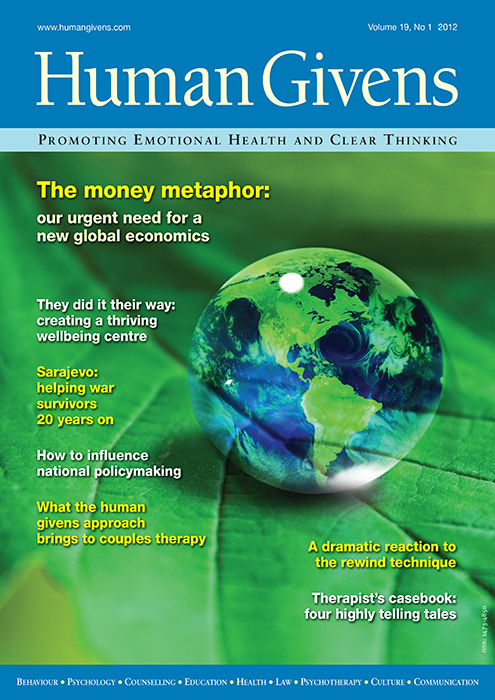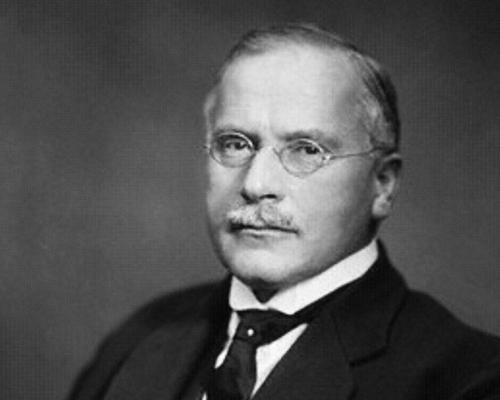Just what couples need
Véronique Chown explores the value of the human givens approach in successful couples therapy.
WHEN Vivian and Miles arrived to see me, they were barely able to speak to each other. Vivian was an attractive woman in her late 30s, who clearly took great pride in her appearance. Her nails were immaculately polished, her hair well coloured and styled, and her clothes chosen with care. Miles, in contrast, wore somewhat worn-looking jeans and a crumpled shirt.
They sat at far ends of the sofa in my consulting room, Vivian leaning towards me earnestly, wringing her hands in her lap, and Miles pressed as far back into the sofa cushions as he could get. He looked sullen and hardly said a word as Vivian launched into what she saw as the problems in their relationship: he didn’t pay her any attention and didn’t want to spend time or go places with her anymore. When he was at home, he was either playing with the kids or he withdrew to somewhere in the house where she was not. But he was very interested in other women – she knew that for a fact, even though he denied it. Miles sat there morosely, not bothering to deny anything.
I have worked with couples for over 20 years, dealing with a whole host of relationship problems, such as disillusionment, infidelity, jealousy, boredom, loss of love, personality differences, sexual difficulties, anger, violence and life-changing events, such as the loss of a child or a job. Sometimes the relationship can be set back on track; at other times a couple may need help to part. But it wasn’t until I came across the human givens approach and its particular framework for therapy that I learned how to cut to the heart of confused and convoluted presenting problems extremely quickly and help the couple to find a swift, satisfying and workable solution.
In couples therapy, the essential tenets of individual human givens therapy still hold, but in relation to each other as well as individually. I keep in mind the following three questions: What does this couple want? What do they need to move forward? And how can I best help them to make a difference straight away? For those who sincerely want their relationship to recover and thrive, the aim is to guide them towards ways of behaving that enable both to use their innate resources to meet their own and each other’s essential emotional needs: successful relationships depend on mutual needs satisfaction. Difficulties occur only when essential needs are not met in reasonable balance, or resources are being used incorrectly, so the first task for the therapist is to find out what is preventing this from happening.
When this is recognised as key to successful therapy and the information is shared with distressed couples, complaints/difficulties can be re-interpreted in terms of unmet needs. This in itself serves as a reframe. For example, Maggie complained about the amount of time Peter spent online, while Peter complained that Maggie was constantly on his back. When the complaint was reinterpreted as the need for attention to be better met, the couple were soon able to find their own solutions.
Many couples therapists still place an emphasis on attachment theory and attachment behaviour, which is of course relevant; no one can deny that the quality of past experiences of attachment to early caregivers, or a lack of it, has a conditioning effect. Insecure attachment, for example, can manifest as a pattern of insecurity and failed relationships in adulthood. However, although exploring such issues can be useful for some, it is a lengthy and time-consuming process and often does not meet clients’ expectations for change. Most clients want to move forward; they want to feel better and find solutions to their problems. The human givens therapist works directly with the problem patterns, detraumatising abuse or neglect from the past, using the rewind technique, or reframing non-traumatic but unhelpful learning from childhood upbringing, thus opening the way to moving on and transforming a present-day relationship that has run into difficulties. As we know, it is perceptions of past events and their significance that can be changed, but not the events themselves, so it is not useful to dwell on them.
When we understand the importance to wellbeing of essential emotional needs (such as security, attention, status, connection and meaning), we can see why good communication between couples, although crucial, is not the only predictor of a healthy relationship – and not the entire solution to an ailing one; and why having interests in common is not necessarily essential either. Adherence to such pervasive beliefs certainly slowed up my progress during my early days as a couples therapist. But now I know that what matters most is needs being met in ways that work for each individual couple.
I find that couples therapy is most swiftly and satisfactorily concluded when using exactly the same RIGAAR™ therapy framework – Rapport building, Information gathering, Goal setting, Accessing resources, Agreeing strategies and Rehearsing success – as in individual human givens therapy. Rapport building may be particularly challenging, however, as it is common for one partner not to want to engage in therapy. I make a point of warmly trying to connect with both partners equally, asking questions that guarantee me a yes – “So you found me?” “I see the sun is shining” – and keep going until I elicit at least an assenting grunt from a partner who is present reluctantly. I note the body language as they sit down – for example, an unwilling male participant may slump with his legs thrust out and his arms folded, while a reluctant female may tend to hunch in a corner.
As the common pattern is for the ‘keen’ one to do all the talking and to feel embarrassed by their partner’s silence (which seems to imply that they have nothing to do with the problem being expressed), I try to avert this by saying something like, “Since you have both taken the trouble to be here, it would be good to hear from each of you what you would like to get out of the session”. If one won’t engage, I put questions to them, asking whether they see things the same way as their partner or differently (that usually encourages a response), and try to mirror aspects of the body language of the person I am addressing – leaning back when talking to a withdrawn male and forward when talking to the eager partner. Occasionally there is absolute silence, but I use that to observe, “Is this what it is like when you try to talk to each other?” I don’t give up because I know that the ice will get broken eventually.
Useful information
I allow the couple to tell me their story in their own way and observe how they interact together. If necessary, I set some ground rules: that we listen without interrupting the person who is speaking (bearing in mind that this is a conversation, not a monologue); that one of us feeds back the emotional content of what they have heard (reflective listening), to be sure we have understood correctly; and that the couple keep to the issue under discussion and do not resort to insults or accusations or raise past hurts.
Then I ask questions that will give me concrete information to work with. When did the problems start? What was happening at that time? When do they not experience these problems? And so on. It is only when I have a clear picture of what has brought them to see me, and I have summarised it, that I begin to seek out their resources. I need to know what problems they have had in the past and how they managed to solve them. Was there a time when they had problems similar to those experienced now and, if so, how did they overcome them? What was their relationship like when it was going well? What attracted them to each other? As so much of what is on top for couples is negative, it is powerful to divert their attention towards what once used to work in their relationship and revive the pattern of what they might be able to return to. These are gold nuggets to feed back to them during guided imagery.
As a couples therapist, I find I listen especially intently – not only to the individuals’ own perceptions and beliefs but to how they react with each other, how they interpret what they hear, the meaning they ascribe to problem behaviours, what presses their buttons, and so on. I keep in mind that there may be a split agenda, with only one person wanting the relationship to continue and the other wanting a quick exit. In such cases, individual sessions are useful to determine exactly where the therapy is going. Sometimes I suggest that we adopt a ‘wait and see’ attitude and proceed with therapy on the understanding that it is an exploration of the potential of any future relationship.
Different meanings
I make sure to tease out the meaning of what are, for some couples, everyday sources of stress. Common differences have to do with money, household chores, different styles in parenting, frequency of sex, etc. When Sue and Ryan moved in together, what exercised them both most was Sue’s adored cat. She wanted it to sleep on the bed with them, because it had always slept on her bed before they got together, and he found this an outrageous idea, as he wasn’t especially keen on animals. She interpreted his rejection of the cat as rejection of her, while he interpreted her insistence on its presence on the bed as contempt for him. These assumptions never got identified because the exchanges were restricted to sentiments such as, “Get that filthy cat off the bed!” “She’s no filthier than you are, stupid!” Sue realised that she didn’t really need the cat to be on the bed – it was just habit and she was fine about giving it a basket on the floor. She also realised that, far from rejecting her, Ryan was showing loving behaviour, because he would actually have preferred no cat to be around at all. Ryan realised that Sue had not meant anything hurtful by expecting the cat to sleep on the bed and appreciated her willingness to change the practice. Once this seemingly trivial problem was addressed, it was relatively easy to iron out everything else, too – ‘the domino effect’.
When I’m gathering information, I am looking for patterns that need breaking and ‘solution’ patterns that need encouraging. I also give information, where appropriate, which in itself helps to lower the emotional temperature. For instance, it is a revelation to many couples how differently male and female brains work. When stressed, the female brain is wired to talk whilst the male brain is wired for action. So, when a woman wants to offload the problems she had at work that day, the man tends to do the male thing of looking instantly for solutions to those problems and voicing them long before she is ready to hear them. With this new understanding, the man can learn to empathise first and listen without interrupting before offering any solution, whilst she can learn to make allowances when he forgets. Similarly, it is helpful for couples to learn that the intensity of passion which occurs at the start of a relationship is facilitated by high levels of the ‘love’ hormone oxytocin – but within a year nature turns down the hormone level, as other things, such as getting on with normal life and raising a family, become more important, and more key needs are met.
Sometimes information is all that is needed to help couples reframe how they view their predicament and, of course, appropriate metaphors and stories also help widen their perspectives.
During information gathering I keep in mind that the relationship may not be the source of the problem. For instance, someone might be exhibiting jealousy and distrust because their last lover cheated on them. Sometimes, that person is happy for me to do the rewind detraumatisation treatment there and then, while their partner is with them in the room. Or, if they prefer, I will see that person separately, purely for that purpose. If it seems as if there might be something unspoken which is getting in the way of moving the relationship forward (such as an undisclosed affair or domestic violence), I offer both partners a session on their own (it is important to be even handed, so that neither thinks I am colluding with the other). When I suspect physical abuse, I see the perpetrator first and, if my suspicions are confirmed, I ensure I have a plan ready to offer the other party at their session (including details of a safe refuge and a number to call), to enable them to leave the relationship safely if they need to.
Old patterns
Alan and Rosie came to see me because of Alan’s controlling behaviour and anger outbursts, which would come out of the blue. He didn’t know why, except that he recognised that it happened at times when his wife had to put the needs of their young children first, particularly in the evenings, which left him feeling pushed out and ignored. Things came to a head when Rosie found him looking at internet dating sites. When I saw him alone, further probing revealed that it happened whenever he felt abandoned and deprived of attention. He recognised this as a pattern that had precipitated the start of previous affairs and the end of other relationships but he felt confused because the last thing he wanted to do was to break up his family.
We decided to work directly with the emotions associated with the problem. I asked him to get in touch with those painful feelings by recalling a recent time when he had felt them. I then invited him to ‘stay’ with the feelings and allow his mind to float back to a time when he first had those feelings (a technique known as the affect bridge). After several moments, he reported a memory of being left, at the age of seven, in the care of his 17-year-old brother every day after school, as his mother was working. His brother had a girlfriend, who would come to their house, and the pair would spend the whole time till the mother’s return canoodling on the sofa or disappearing from the room altogether. Alan had no chance to play and chat and felt miserable. So, when his wife was unable to give him attention when he wanted it, his mind was pattern matching on an unconscious level to this time from his childhood when his attention needs hadn’t been met.
In trance he remembered vividly the feelings of rejection, loneliness, anger and frustration from that time. I asked him if he had ever expressed those feelings and he said that he hadn’t. I then suggested to him that, in the privacy of his own mind, he could, if he wanted to, empty himself of all that unexpressed anger, frustration, hurt and pain. I told him that he should take as long as he needed to do this and to give me a nod when it was done. After a couple of minutes, I noticed the change in his breathing as his whole body relaxed. I then used guided imagery to reinforce, and to seed, new healthy patterns. In later joint sessions, we were able to work on finding ways in which Rosie and Alan could mutually meet each other’s needs for attention and connection – which included Alan playing a part in the children’s bedtime rituals. The work we did together dissolved the pattern and Alan never again experienced those overwhelming feelings of rejection when Rosie was busy with something else.
Alan was able to access his emotions easily, but this is not the case for everyone. There are many people who are more left brained, rational, logical and systematic in the way they think. Often, one member of a couple seeking my help is on the autistic spectrum – unsurprising because a key difficulty for those on the spectrum is that they don’t have the normal templates for empathy, which in itself leads to problematic relationships. Human givens therapists adjust their way of working to suit their clients, so I work with any left-brained person cognitively, using logic, and sometimes using a technique known as an ‘inference chain’. This is useful for revealing cognitive distortions and helping the person to detach from unrealistic beliefs.
Jealousy
Ron was married to a much younger woman and was extremely insecure about his place in her affections, which led him to be enormously angry and jealous if he saw her laughing or talking with any other man – including the postman, delivery men and, more problematically, the neighbour next door, whom he became convinced she was having an affair with. Her denials did nothing to assuage his pain. So, in a session on his own, I asked him what his first thought was when he saw her laughing with the neighbour. “They are seeing each other.” I entered his model of reality by asking, if that were the case, what that meant to him. “I’m not enough for her.” Then? “She’ll leave me.” Then? “There’s no point. I might as well not be here.” I then asked him to name the feelings that were fuelling this thinking. He said he felt enraged, lost, lonely, and confused.
Then I invited him to distance himself from the problem, to calm himself down using 7/11 breathing and to imagine himself as a fly on the wall, which could see what was really happening. I told him that all I was interested in was the truth and that he was to use his logical, rational mind to answer me. We questioned each statement in turn, looking for evidence, after which I asked him, “So how true is this in reality?” He invariably answered, “Not true.” I wrote all his responses down and showed them to him afterwards. Then I asked him to think about his wife talking and laughing with the neighbour and tell me how he felt. He reported that the rage and pain had evaporated. We reframed the problem as an error in his thinking and, if it ever surfaced again, Ron now had the tools to deal with it himself.
Unpacking ‘goals’
As in individual therapy, goal setting is crucial. Usually the goals for the therapy will emerge naturally from solution-focused questioning, such as “How will you know the therapy has worked?” “What will you be doing differently?” This requires each person to use their imaginations to see themselves in a positive relationship with each other. I make sure that I unpack the meaning of any nominalisations (abstract nouns with no concrete meaning), rather than accepting them at face value and putting one’s own interpretation on them – which therapists can be as guilty of as the couple. So, when one partner says that ‘caring’, ‘sharing’ ‘support’ or ‘respect’ are important to them in a relationship, I steer them towards how this might be manifested in practice, and it is educational for all three of us. For instance, one partner might see caring as being given hugs whereas the other might think it caring to volunteer to do the shopping. I ask questions such as, “How will you know when there is more respect in your relationship? How will that show?” If they can’t describe the desired action, change is highly unlikely to happen.
Having completed the Emotional Needs Audit together during the session, and scaled how well they each feel their needs are being fulfilled, we arrive at goals directed towards meeting more of those needs. Occasionally if a couple just cannot come up with a goal that is positive, achievable and needs oriented, I will suggest a small short-term goal, presenting it as something of an experiment: “I’d like you to be curious and notice what happens when...” It could be something as simple as agreeing to take a walk together before the next session and to avoid problem-talk.
The ‘defuser’
One highly effective tool that I teach and encourage couples to use to prevent negativity from escalating is the ‘defuser’ – some little sign that one of them is crossing a boundary/getting unhelpfully upset/angry and so forth. It could be an agreed physical action, such as tweaking the other one’s ear or squashing one’s own nose, or it could be a neutral word (or one with nice associations) that they agree as a signal for calming down. Examples I have heard include “Disengage!”, “Time out!”, and “Rainbow!” (as in pot of gold being aimed at). It’s best if humour can be involved.
During sessions I always point out any instances of what relationship expert Dr John Gottman (who has researched this area for over 35 years, studying the behaviour of over 7,000 couples in the process) calls “a harsh start-up”. By this, he means the readiness with which couples will take offence at what the other has said, negatively interpret what they think they have heard, and escalate conflict. So, for instance, Joshua comes home from work thinking it would be nice to go out for a meal with his wife Gloria. He greets her and says, “What are we doing for supper tonight?”, hoping she hasn’t cooked anything yet. Gloria is frazzled, having had a hard day at work and immediately takes umbrage at what she reads as the suggestion that she should have dinner ready. “Why do you expect me to make the dinner all the time? We both work full time!” she spits at him. Joshua instantly gets caught up in what he perceives as the injustice of her words (forgetting completely that he had a meal out in mind): “What do you mean, always? I cooked only last week.” “Oh, Mr Jamie Oliver, I don’t think! Once in a blue moon!” And they are off. So I make sure couples know the importance of lowering the emotional temperature through 7/11 breathing and continually checking out their understanding of what their partner is meaning. I often set this as a task.
Rehearsing success is the final step of RIGAAR™. As we know, the more the couple can imagine themselves behaving in the specific ways that are conducive to a recovered, satisfying relationship, the greater the likelihood of achieving it. I use guided imagery with both partners together towards the end of the session to embed what we have achieved, make them more confident of their resources and strengthen their determination to meet their goals. I ask them to bring to mind joyful occasions from their past, using all their senses, and then ask them to imagine themselves carrying out their agreed tasks together, with all their former pleasure and enthusiasm.
Sometimes one partner is not comfortable doing guided imagery, or even simple relaxation, and there are some who feel unsettled closing their eyes. This is not a problem at all; whilst one partner closes their eyes, I suggest the other concentrates on keeping their eyes open. I tell them that it really doesn’t matter what they focus on – just make themselves comfortable in any way they choose. And I carry on as normal.
Always the needs
While what I do within a session varies, always at the front of my mind are the essential innate needs. At the start of this article I introduced Vivian and Miles, who had reached a point where their relationship was totally devoid of joy. Vivian was suspicious and jealous; Miles was morose and withdrawn. We didn’t get far in the first, joint, session, so I saw them both separately. In Vivian’s session, it emerged that, when out of town visiting a cousin, she had gone to a country restaurant where she had seen, to her horror, her best friend’s husband enjoying an intimate meal with another woman. She was in turmoil as to what to do and, in the end, decided not to tell her friend but made it clear to the husband that she knew. Shortly afterwards, she noticed that her own husband had put on one of his nicest shirts just to go on some errands. Suspicious, she accused him of an affair, which he vehemently denied. This didn’t satisfy her, however, and she began to become obsessed with her suspicion, following him, texting him 20 times a day and even dropping in on him at work unexpectedly, making him a laughing stock with his colleagues at the estate agents where he worked. Of course their relationship had deteriorated horribly; sex was off the menu and they never spent time together.
We identified which needs had become unmet because of their current difficulties. In her insecurity, she was pushing him away; he felt that he was walking on eggshells, overwhelmed and anxious and wondering what she was going to do next – so his sense of autonomy was compromised. There was no exchange of good-quality attention between them any more and no intimacy.
I was puzzled as to how Vivian had the time to do all the texting and chasing and it emerged just how unstretched she was in her daily life and how much she fell back on seeking status through being a ‘yummy mummy’. When she wasn’t actively pursuing Miles she would spend hours at the beauty salon having various treatments, before checking on him again. She was clearly an intelligent woman and said wistfully that she would have liked to train to be a teaching assistant – a vacancy had come up at her children’s school. I pointed out that doing the training could help in fulfilling important needs and encouraged her to explore the possibilities. I reminded her, in guided imagery, of how good a man Miles was, how he was not in any way similar to her best friend’s husband, that there was no evidence of his unfaithfulness whatsoever and that the consequence of her unnecessary suspicions was the potential ruination of her own loving marriage. I then impressed upon her how important it is for our health and wellbeing to be sufficiently challenged and that, when our brains aren’t busy enough, they get into mischief. Vivian did decide to undertake the training and, as she became absorbed and engaged in meeting a very important need, the suspicious behaviour evaporated, and she and Miles were able to rebuild their relationship.
As a human givens therapist, I have many ways of making interventions to help couples that want to stay together. However, I always point out that there is no such thing as a problem-free relationship. All successful relationships accommodate differences and divisions, niggles and irritations. So, rather than looking for a problem-free relationship, we all need partners whose particular problems we can cope with – and who can cope with ours. Successful couples find their own coping strategies and keep moving forward towards mutual needs satisfaction; the trick is to help distressed couples use their innate resources to do the same.
Identifying details of clients have been changed.
Véronique Chown is a psychotherapist with over 20 years of experience in private practice and the NHS. Her original background was in education as head of modern languages and in pastoral care, before she retrained in psychology and psychotherapy.
This article first appeared in Volume 19 - No. 1: 2012 of the 'Human Givens Journal'
 Spread the word – each issue of the Journal is jam-packed with thought-provoking articles, interviews, case histories, news, research findings, book reviews and more. The journal takes no advertising at all, in order to maintain its editorial independence.
Spread the word – each issue of the Journal is jam-packed with thought-provoking articles, interviews, case histories, news, research findings, book reviews and more. The journal takes no advertising at all, in order to maintain its editorial independence.
To survive, however, it needs new readers and subscribers – if you find the articles, case histories and interviews on this website helpful, and would like to support the human givens approach – please take out a subscription or buy a back issue today.
Latest Tweets:
Tweets by humangivensLatest News:
SCoPEd - latest update
The six SCoPEd partners have published their latest update on the important work currently underway with regards to the SCoPEd framework implementation, governance and impact assessment.
Date posted: 14/02/2024
2024 Conference
Our next in-person HGI Conference, is being held on the weekend of 20th and 21st April 2024













